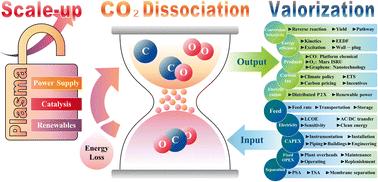低温等离子体使二氧化碳解离:等离子体设置和转换机制的关键分析,以扩大价值
IF 9.2
1区 化学
Q1 CHEMISTRY, MULTIDISCIPLINARY
引用次数: 0
摘要
二氧化碳解离作为碳利用的重要途径之一,对可持续的碳减排具有重要作用。低温等离子体(LTP)技术具有高活性的特点,可以有效降低CO2活化的能量势垒,从而在降低能量需求的情况下实现CO2的高效解离。近年来,ltp使CO2解离引起了广泛的研究兴趣,旨在提高转化性能和推进规模化应用。实现这一目标需要从等离子体设置(如电源、原位和后处理控制策略)和转换机制(包括诊断技术、反应动力学模拟和多物理场建模的见解)两方面进行双重考虑。在概述了不同等离子体系统的基本特征以及热催化和等离子体催化驱动的CO2解离过程之间的区别之后,本文通过对LTP驱动的CO2解离的实验成果和机理研究的综合分析,研究了LTP设置和转化机制的当前发展和存在的局限性。基于这些发现,我们提出了ltp使二氧化碳增值从实验室研究到大规模实施的战略展望。本文章由计算机程序翻译,如有差异,请以英文原文为准。

Low-temperature plasma-enabled CO2 dissociation: a critical analysis of plasma setups and conversion mechanisms toward scale-up valorization
CO2 dissociation, as one of the key pathways for carbon utilization, plays a critical role in sustainable carbon emission reduction. Low-temperature plasma (LTP) technology, with its highly reactive characteristics, can effectively lower the energy barrier for CO2 activation, thus facilitating efficient CO2 dissociation with reduced energy requirement. LTP-enabled CO2 dissociation has attracted widespread research interests aiming to enhance conversion performance and advance scale-up applications in recent years. Achieving such an objective necessitates dual-level considerations from both the plasma setups, such as power supplies, in situ and post-treatment control strategies, and the conversion mechanisms which encompass insights from diagnostic techniques, reaction kinetics simulations, and multi-physics modeling. Following an overview of the basic characteristics of different plasma systems and the distinctions between the CO2 dissociation processes driven by thermal catalysis and plasma catalysis, this review examines the current developments and existing limitations in LTP setups and conversion mechanisms through comprehensive analyses of experimental achievements and mechanistic investigations in LTP-enabled CO2 dissociation. Based on these findings, we propose a strategic outlook for the progression of LTP-enabled CO2 valorization from laboratory research toward scale-up implementations.
求助全文
通过发布文献求助,成功后即可免费获取论文全文。
去求助
来源期刊

Green Chemistry
化学-化学综合
CiteScore
16.10
自引率
7.10%
发文量
677
审稿时长
1.4 months
期刊介绍:
Green Chemistry is a journal that provides a unique forum for the publication of innovative research on the development of alternative green and sustainable technologies. The scope of Green Chemistry is based on the definition proposed by Anastas and Warner (Green Chemistry: Theory and Practice, P T Anastas and J C Warner, Oxford University Press, Oxford, 1998), which defines green chemistry as the utilisation of a set of principles that reduces or eliminates the use or generation of hazardous substances in the design, manufacture and application of chemical products. Green Chemistry aims to reduce the environmental impact of the chemical enterprise by developing a technology base that is inherently non-toxic to living things and the environment. The journal welcomes submissions on all aspects of research relating to this endeavor and publishes original and significant cutting-edge research that is likely to be of wide general appeal. For a work to be published, it must present a significant advance in green chemistry, including a comparison with existing methods and a demonstration of advantages over those methods.
 求助内容:
求助内容: 应助结果提醒方式:
应助结果提醒方式:


